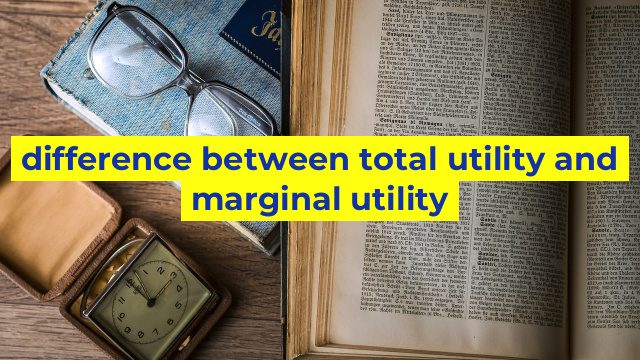Understanding the Difference Between Total Utility and Marginal Utility
In economics, utility refers to the satisfaction that one derives from consuming a good or service. It is an important concept as it helps determine how much of a good or service one is willing to purchase. There are two types of utility, namely total utility and marginal utility. While both are important, they are different in nature and serve different purposes.
Total Utility
Total utility refers to the total satisfaction that one derives from consuming a good or service. It is the sum of all the satisfaction levels that one gets from consuming a particular good or service. For example, if John consumes five slices of pizza and derives a total utility of 20 units of satisfaction, it means that he has derived an average satisfaction of four units per slice of pizza.
The concept of total utility is important as it helps consumers determine how much of a good or service they require to achieve a certain level of satisfaction. It also helps producers determine the optimal amount of a good or service they should produce to meet consumer demand.
Marginal Utility
Marginal utility, on the other hand, refers to the additional satisfaction that one derives from consuming one additional unit of a good or service. It is the change in the total utility as a result of consuming one more unit of a good or service.
For example, if the first slice of pizza that John consumes provides him with a total utility of 5 units, and the second slice provides him with a total utility of 8 units, then the marginal utility of the second slice is 3 units (8 – 5). In other words, the second slice of pizza provided John with an additional 3 units of satisfaction.
The concept of marginal utility is important as it helps consumers determine how much they should consume of a particular good or service to maximize their overall satisfaction. It also helps producers determine how much of a good or service they should produce to ensure that they are meeting consumer demand.
The Difference Between Total and Marginal Utility
While both total utility and marginal utility are important concepts in economics, they serve different purposes. Total utility is the overall satisfaction that one derives from consuming a particular good or service, whereas marginal utility is the additional satisfaction that one derives from consuming one more unit of the same good or service.
Total utility helps consumers and producers make decisions about how much of a good or service they require, whereas marginal utility helps them make decisions about how much they should consume or produce to ensure that they are maximizing their overall satisfaction.
In conclusion, the difference between total utility and marginal utility lies in the nature of the satisfaction they represent. While both concepts are important, they have different implications for decision-making and are used in different ways by consumers and producers. By understanding these concepts, individuals can make informed decisions about their consumption and production choices.
Table difference between total utility and marginal utility
| Utility | Definition | Difference |
|---|---|---|
| Total Utility | The total amount of satisfaction or pleasure a consumer receives from consuming a certain quantity of a product | Total utility is the sum of marginal utilities of all units consumed till a certain point |
| Marginal Utility | The additional satisfaction or pleasure a consumer receives from consuming an extra unit of a product | Marginal utility decreases as consumption of a product increases due to diminishing marginal utility |


